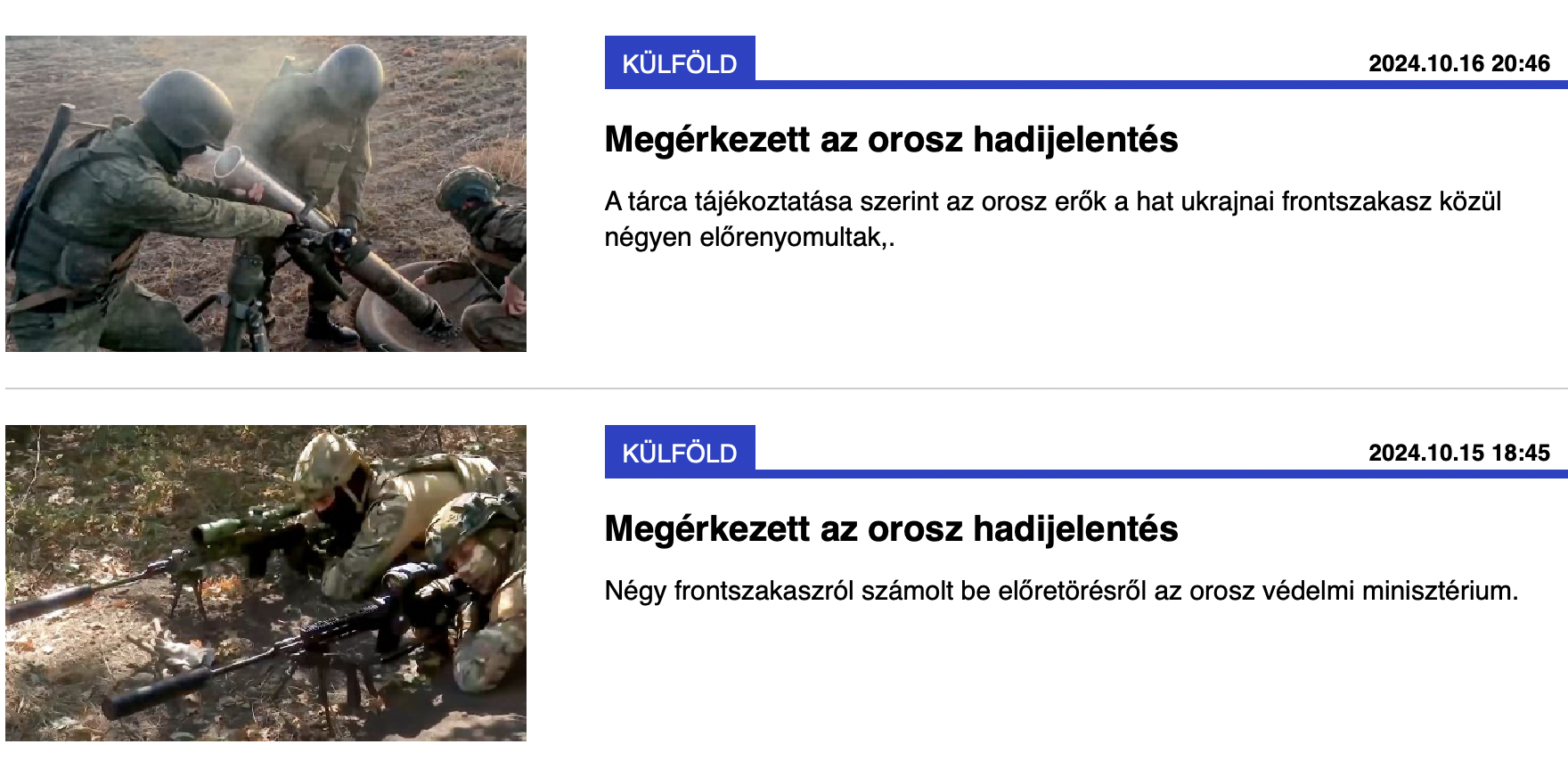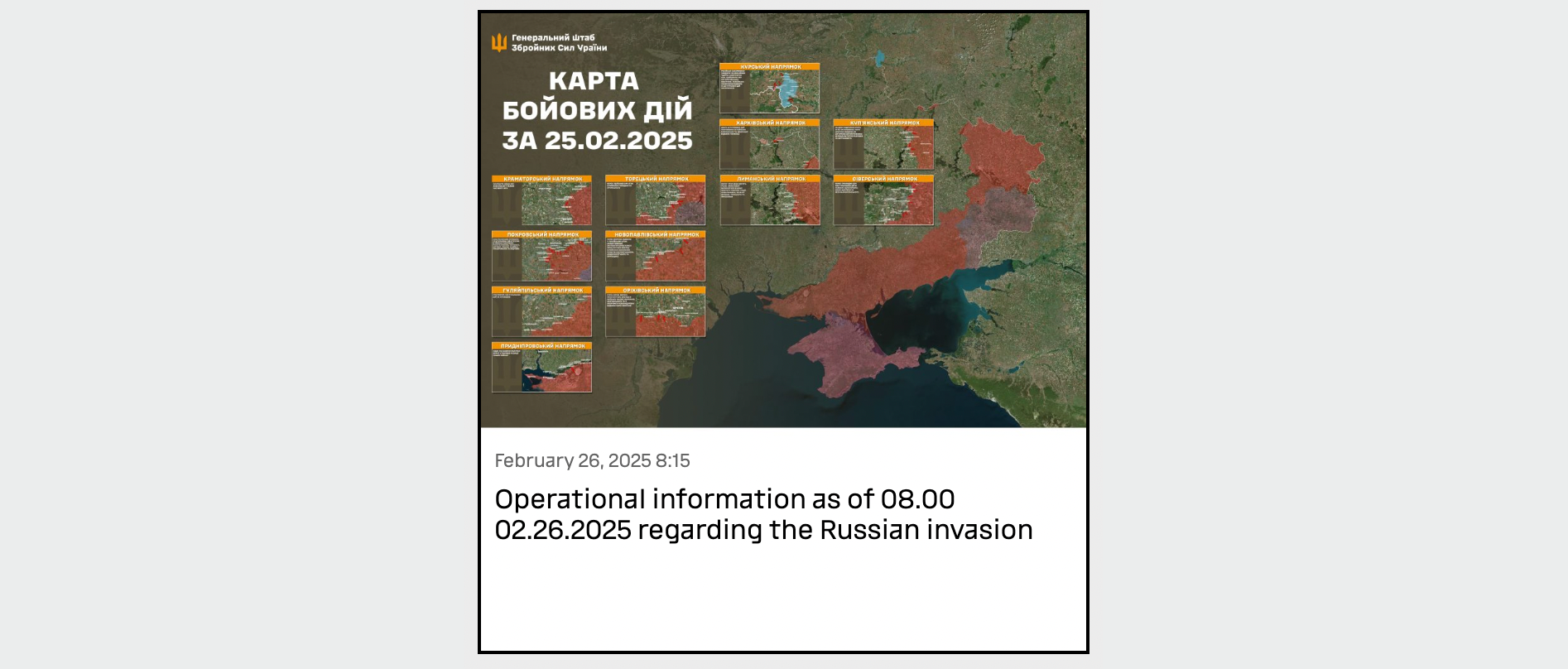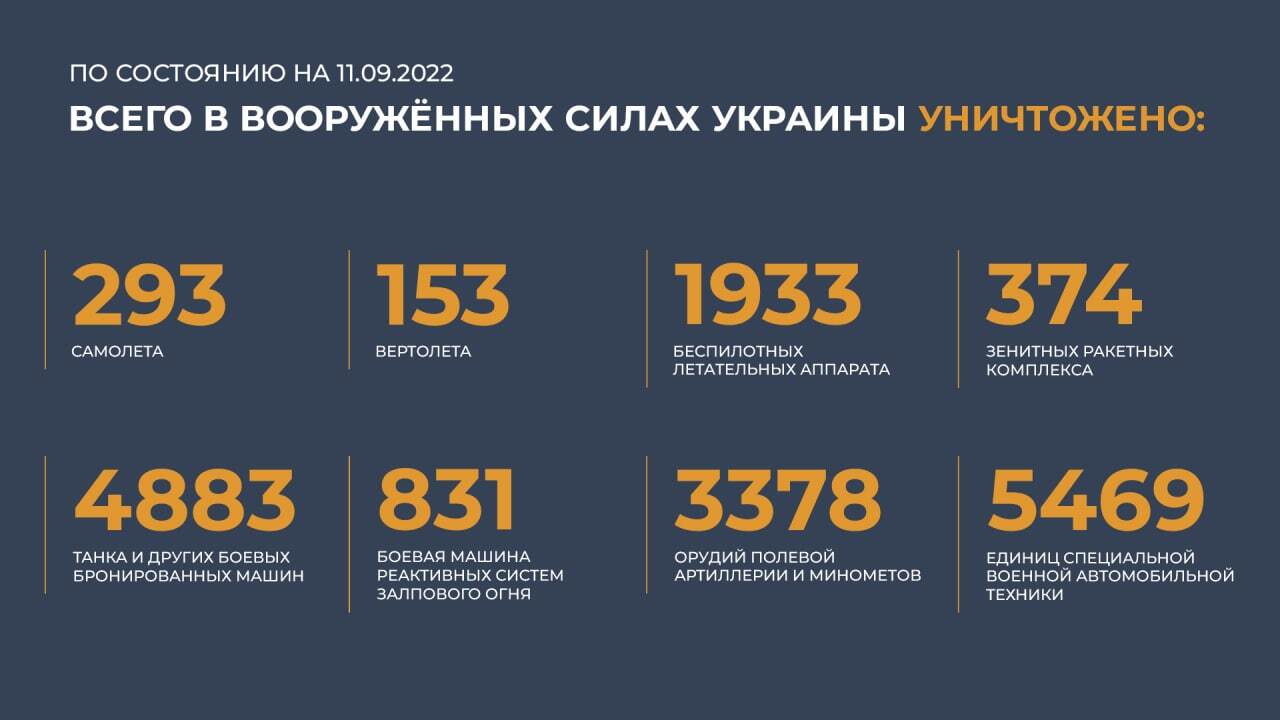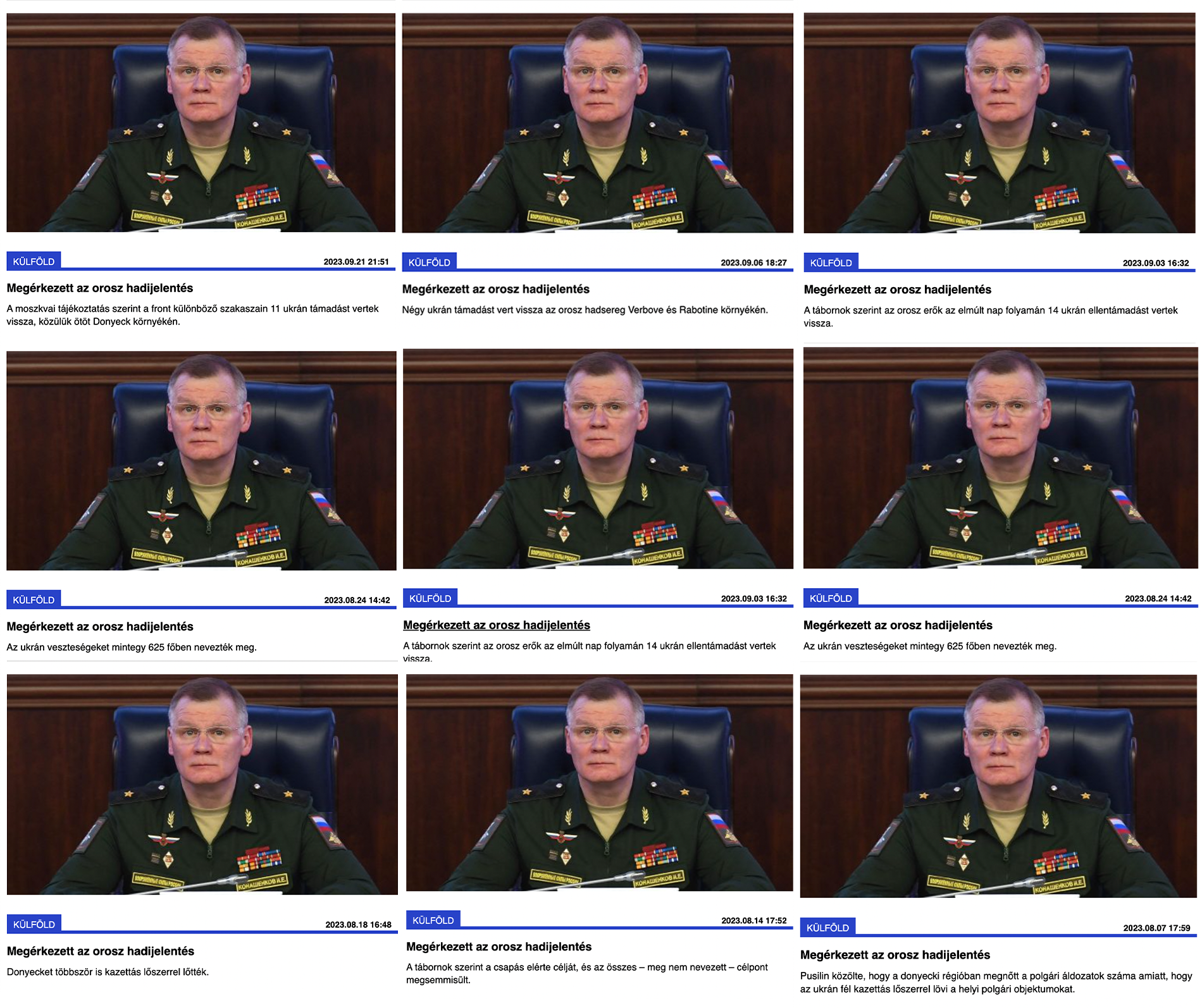Hungarian state news site has published dubious Russian war reports more than 600 times since the outbreak of the war
2025. március 6. 13:14
Ezt a cikket 2025
márciusában írtuk.
A benne lévő
információk azóta elavulhattak.
Official military updates from Ukraine made it into Hungarian public media’s war coverage only half as often as those from Russia. According to security expert Krisztián Jójárt, official Russian reports have become so detached from reality that even Russian analysts no longer cite them.
“The Russian war report has arrived.”
Over the past three years, this headline has appeared verbatim more than 250 times on Hirado.hu, the news portal of Hungary’s public broadcaster. While the phrasing suggests that these military reports have made their way into the newsroom in an exceptional fashion, the reality is far less dramatic. Like its Ukrainian counterpart, Russia’s Defense Ministry issues daily updates on the frontline situation.
Arrived. Source: Hirado.hu
Russian updates were typically labeled as “war reports”, while Ukrainian ones were referred to as “battlefield situation reports.”
In this analysis, we examine:
- What kind of information the warring parties provide in their official military updates and how reliable are these reports;
- How frequently Hungary’s public media referenced Russian and Ukrainian sources;
-
And how Hungary’s public media platform framesRussian and Ukrainian reports differently on.
For our research, we reviewed all hirado.hu articles published between February 24, 2022, and February 24, 2025, that included the terms “war report” or “situation report” and covered the war in Ukraine. (To collect the data, we used the site’s internal search engine and extracted information using the Instant Data Scraper Chrome extension.) The keyword search returned nearly 1,000 articles, which we categorized based on various criteria—including which side issued the report.
All of these articles were filed under hirado.hu’s “Ukrainian crisis” tag, and the majority were based on reports from Hungarian state news agency MTI.
A Persistent Imbalance
“On three Ukrainian front sections, Russian armed forces repelled 18 attacks in the past 24 hours, resulting in more than 760 Ukrainian casualties—killed or wounded. Destroyed Ukrainian military assets include a MiG-29 fighter jet, four tanks, two infantry fighting vehicles, four armored combat vehicles, three Polish Krab self-propelled howitzers, two American M109 Paladin self-propelled guns, seven American M777 howitzers, a British FH70 towed howitzer, two HIMARS rockets, a JDAM guided aerial bomb, and 26 drones.”
Statements like these appear regularly in the military reports issued by both sides in the war, summarizing daily combat events, troop movements, and enemy losses in personnel and equipment.
Hungary’s public media coverage of the war primarily relies on two sources:
- the Russian Defense Ministry’s statements, consistently published under the label “war report”, and
-
the Ukrainian General Staff’s updates, which hirado.hu typically categorizes as “battlefield situation reports.”
Since February 2022, Hungary’s state-funded news portal has cited official Russian sources 633 times in war-related articles containing the terms “war report” or “situation report.” Ukrainian sources, by contrast, were referenced only 325 times.
Throughout three years of war, the ratio of Russian to Ukrainian military reports published on hirado.hu remained steady at 2-to-1 in favor of Moscow. This disparity persisted even as the overall number of reports from both sides saw a slight decline compared to the first year of the conflict.
The Russian Ministry of Defense publishes its official reports around noon each day under the title: "Russian Defense Ministry reports on the progress of the special military operation." Since Ukraine’s counteroffensive in August 2023, a second daily update has also been issued in the early afternoon, titled: "The Armed Forces of the Russian Federation continue to repel the AFU attempt to invade the territory of the Russian Federation." Both reports are available in English on the ministry’s website and official Telegram channel.
Source: eng.mil.ru/special_operation/briefings
Meanwhile, the Ukrainian government also provides daily updates on the war, which escalated in February 2022. The General Staff of the Armed Forces of Ukraine publishes a morning report titled: "Operational Information on the Russian Invasion as of [Date]." These updates are accessible on the official General Staff website and on its Facebook page, which has more than one million followers.
Source: https://www.zsu.gov.ua/
Not Without Bias
It is hardly surprising that the communications of warring parties are driven by their own strategic interests. This is especially true for battlefield reports: both sides tend to exaggerate enemy losses while remaining conspicuously silent about their own.
Given the tactical nature of these reports, civilian casualties, damage to hospitals, churches, and cultural heritage sites are only ever attributed to enemy attacks. In contrast, when describing their own military actions, both sides emphasize energy or military infrastructure as their primary targets.
This is reinforced by highly partisan language. The Russian Defense Ministry continues to refer to the capture of Ukrainian towns as "liberations," describes the war as a "special military operation," and labels Ukrainian forces as "Nazi units" under a "Kyiv regime." Meanwhile, Ukrainian reports routinely refer to Russian soldiers as "terrorists."
A reader relying solely on Moscow’s official statements might be led to believe that the Russian military "hits every designated target," "foils all enemy attacks," while Ukrainian forces "fail to advance" or "suffer repeated setbacks."
An analysis of articles suggests that even the editors of Hungary’s public media recognize the unreliability of these reports. Many battlefield updates include disclaimers such as:
- "The data has not been confirmed by other sources."
- "The accuracy of claims regarding military operations cannot be independently verified."
-
"Recent battlefield reports have been contradictory. Both sides continue to claim success."
"Official Russian reports are more of a propaganda tool than a factual account of events. They have little connection to reality. This is particularly evident in their estimates of Ukrainian losses—if they were accurate, the Ukrainian Air Force would have been completely wiped out three times over. Even the total amount of Western military aid to Ukraine doesn't match the number of destroyed weapons claimed by Russian reports. The numbers just don’t add up," Jójárt told Lakmusz.
Source: Ukrainian loss data from the Russian Ministry of Defense Telegram channel (September 2022)
Even serious Russian analysts do not consider these victory-laden reports reliable. “You won’t find these figures in the Russian Defense Ministry’s official journals or in the publications of the Moscow-based Center for Analysis of Strategies and Technologies. And these institutions are not opposition voices—they are part of the system,” noted security expert Krisztián Jójárt.
According to Jójárt, Ukrainian casualty reports are also exaggerated, but their overall magnitude aligns with battlefield realities and helps identify broader trends. “If Ukraine reports higher losses, it typically reflects more intense fighting in that section of the front,” he explained. The same cannot necessarily be inferred from Russian data, he added.
For objective analysis, experts turn to sources such as Oryx, which verifies losses with photographic evidence, or the Institute for the Study of War (ISW), an American think tank that publishes independent battlefield assessments.
How Are Reports Framed?
Beyond quoting Russian military updates twice as often as Ukrainian ones, Hungary’s public media presented the two sides’ reports differently as well.
The placement of Russian and Ukrainian reports also differed within news articles. While hirado.hu often compiled multiple sources into a single article—incorporating not only central military briefings but also statements from regional and local authorities, police, and emergency services—the Russian Defense Ministry’s reports were consistently placed at the forefront.
By contrast, Ukrainian General Staff updates were typically relegated to the bottom of the articles.
According to Jójárt, this may reflect the centralized nature of the Russian system, where the government tightly controls what information is made public. This control intensified after the 2023 Prigozhin-led rebellion, when President Vladimir Putin summoned Russia’s war correspondents to the Kremlin, effectively curbing their independence. Before that, many had used Telegram to post more factual battlefield accounts that sometimes contradicted the official narrative.
Face of the war. Source: Hirado.hu
Until October 2023, reports from Russia’s Defense Ministry in Hungary’s public media were consistently accompanied by a portrait of Igor Konashenkov, the ministry’s spokesperson. Known as the face of Russia’s "special military operation", Konashenkov delivered daily briefings for over 18 months—until he suddenly disappeared from the screen in the fall of 2023, without any prior announcement.
In 173 of the analyzed hirado.hu articles, Konashenkov personally delivered the ministry’s battlefield updates. However, after September 27, 2023, his name appeared in just five reports.
Speculation about Konashenkov’s whereabouts began in September 2023, when he missed delivering his daily video briefing for five consecutive days. By May 2023, rumors spread on social media suggesting that he had resigned. In November, the MIG Russia Telegram channel—boasting half a million followers—claimed that Konashenkov remained in his post but that the format of military briefings had changed. According to the Russian news portal News.ru, the Defense Ministry’s Information and Mass Communications Department shifted responsibility for battlefield updates to press officers of Russia’s military groups, allowing them to report directly from the front lines. The ministry itself, however, never officially confirmed this change.
Like the Russian reports, Ukraine’s General Staff releases a daily morning briefing, providing an overview of battlefield developments. However, on hirado.hu, these updates are often blended into articles alongside other sources, making them less prominent compared to their Russian counterparts.
Occasionally, Washington’s Institute for the Study of War (ISW) appears in articles citing Ukrainian sources, though such instances have been rare throughout the war.
This analysis was conducted based on an idea by Mihály Minkó, a data visualization expert, with whom we consulted multiple times on methodological questions during the reporting process.
Cover image: Russian Ministry of Defense
A szerzőről

Német Szilvi
Újságíró, médiakutató. Az álhírek és a dezinformáció terjedését vizsgálja a közösségimédia-kutatás eszközeivel, valamint a technológiai platformok és a rejtőzködő médiaorgánumok szerepével foglalkozik.
Kövess minket
Ne maradj le egy anyagunkról sem, kövess minket máshol is!
Ajánlott cikkeink

Mit tudunk a Berlin utcáin megjelent toborzó plakátokról, amikkel Orbán Balázs szerint a háború logikájába próbálják belesodorni Európát?
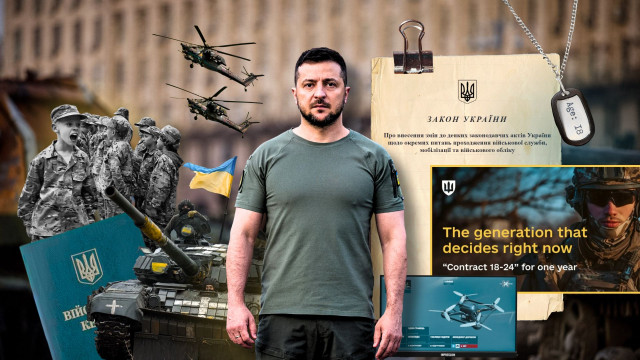
Nincs bizonyíték rá, hogy gyerekeket és Down-szindrómásokat küldenének az ukrán frontra, mégis újra és újra elterjed

